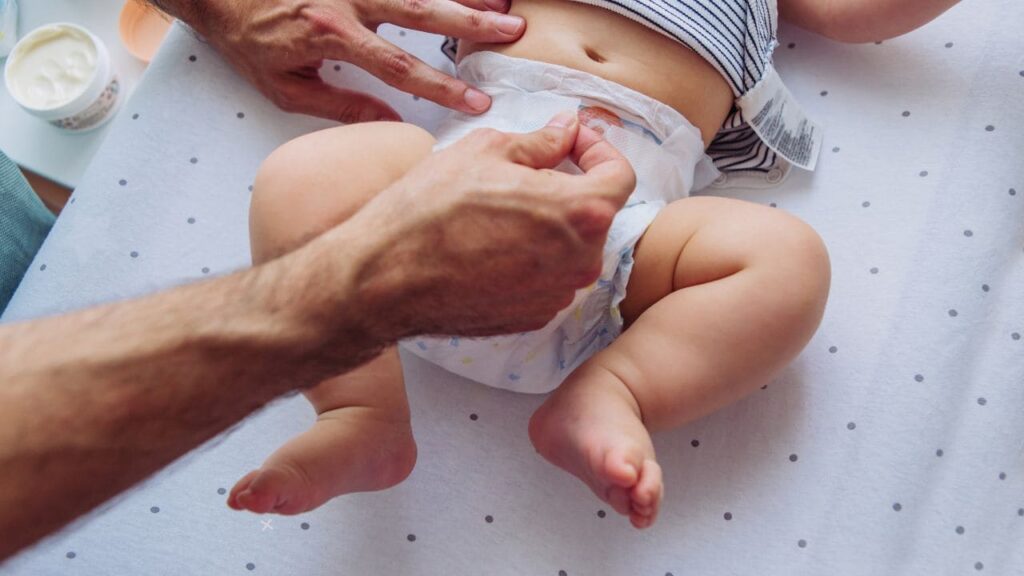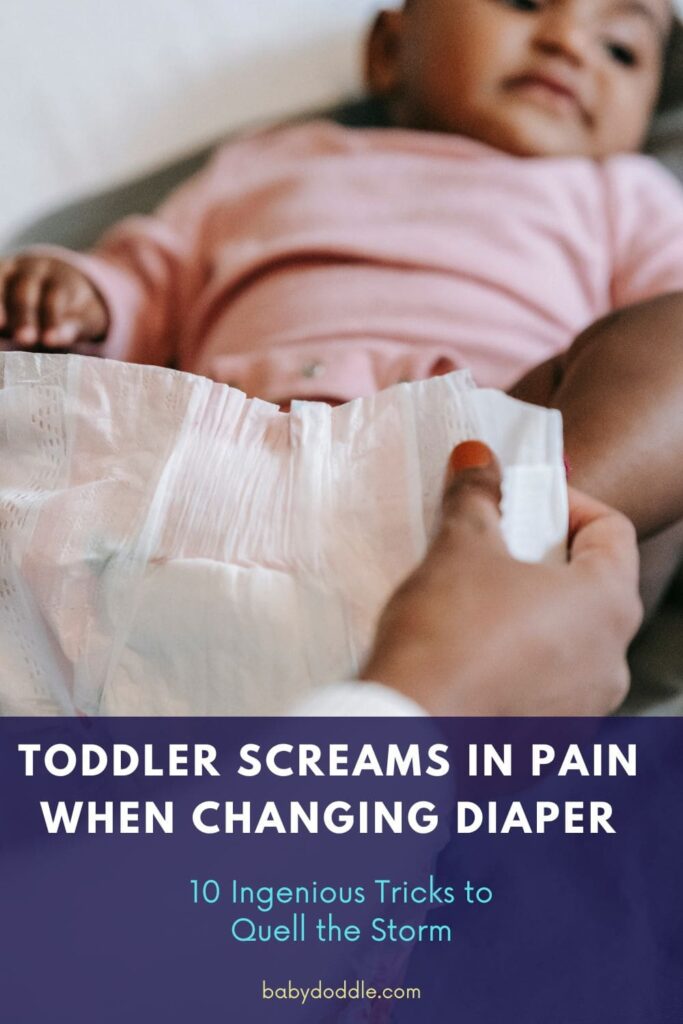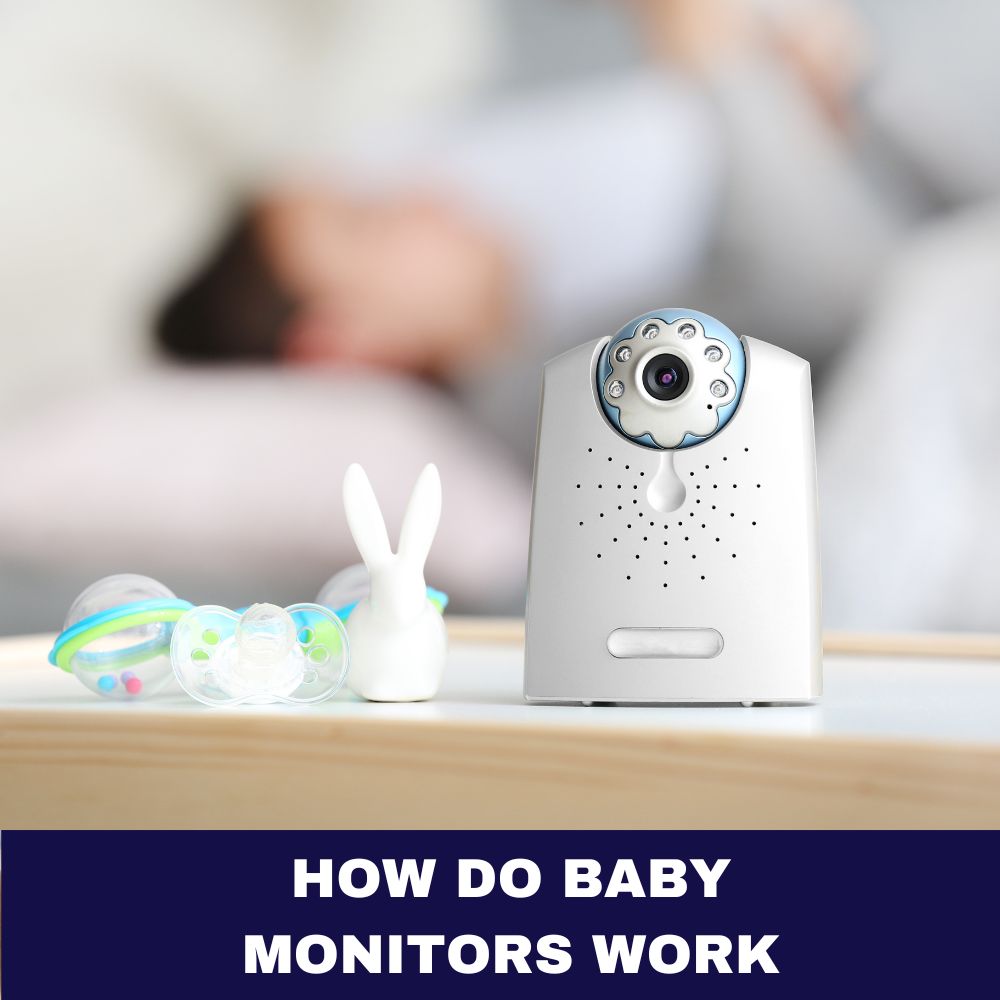Picture this: You’re about to change your toddler’s diaper, and suddenly, the room erupts with ear-piercing screams. Your little one thrashes about as if you’re subjecting them to medieval torture rather than a simple diaper change. Sound familiar? You’re not alone. Many parents face this daily struggle, wondering why their toddler screams in pain when changing diaper. It’s a perplexing and often distressing situation that can leave even the most patient caregiver feeling frazzled.
But don’t despair! In this comprehensive guide, we’ll dive deep into the reasons behind this common issue and equip you with 10 ingenious tricks to turn those stormy diaper changes into smooth sailing. We’ll explore everything from understanding your toddler’s perspective to creative distraction techniques and long-term strategies for peaceful changes. So, take a deep breath, and let’s embark on this journey to calmer, happier diaper changes for both you and your little one.
Understanding the Problem: Why Babies and Toddlers Scream During Diaper Changes
Before we jump into solutions, it’s crucial to understand why your toddler might be screaming during diaper changes. This behavior isn’t just about being difficult – there are often underlying reasons that, once identified, can help guide our approach to more peaceful changes.

Common Reasons for Diaper Change Distress
- Discomfort: Your toddler might be experiencing physical discomfort. This could be due to diaper rash, skin irritation, or even a too-tight diaper.
- Temperature Sensitivity: The sudden exposure to cold air can be shocking for little ones, especially if they were warm and cozy before.
- Loss of Control: Toddlers are in a stage where they’re beginning to assert their independence. Being laid down for a diaper change can feel like a loss of control.
- Interruption: If your toddler was in the middle of play or another engaging activity, a diaper change might feel like an unwelcome interruption.
- Fear or Anxiety: Some toddlers develop fear or anxiety around diaper changes, especially if they’ve had a painful experience in the past (like a severe diaper rash).
- Sensory Issues: Some children are more sensitive to touch, smells, or sounds associated with diaper changes.
- Testing Boundaries: As toddlers develop, they often test limits to see how parents will react.
The Transition from Easy to Difficult Changes
It’s not uncommon for parents to report that their baby used to tolerate or even enjoy diaper changes, only to suddenly start protesting as they enter toddlerhood. This shift often coincides with developmental milestones:
- Increased Mobility: As babies learn to crawl and walk, they become less content lying still.
- Growing Independence: Toddlers start to assert their will and preferences more strongly.
- Cognitive Development: They become more aware of their surroundings and develop preferences and dislikes.
Potential Medical Concerns
While most cases of diaper change distress are not medically serious, it’s important to rule out any underlying health issues, especially if your toddler seems to be in genuine pain. Some potential medical concerns include:
- Severe diaper rash or yeast infection
- Urinary tract infection
- Constipation or gastrointestinal discomfort
- Skin conditions like eczema
- Hip dysplasia or other joint issues
If you suspect a medical issue, it’s always best to consult with your pediatrician for a proper evaluation.
Understanding these factors can help us approach diaper changes with more empathy and creativity. Remember, your toddler isn’t trying to make your life difficult – they’re simply responding to their own experiences and developmental stage. With this knowledge in mind, let’s explore some strategies to make diaper changes smoother for everyone involved.
The Emotional Toll: Coping with Diaper Change Distress
When your toddler screams in pain during diaper changes, it’s not just physically challenging – it can take a significant emotional toll on parents and caregivers too. Let’s take a moment to acknowledge the impact this can have and discuss the importance of managing your own emotions during these trying times.
Impact on Parents
Dealing with a screaming toddler during diaper changes can lead to a range of emotions:
- Frustration: It’s natural to feel frustrated when a simple task becomes a daily battle.
- Guilt: You might feel guilty for causing your child distress, even though you know diaper changes are necessary.
- Anxiety: The anticipation of the next diaper change can create anxiety.
- Exhaustion: Constantly dealing with difficult diaper changes can be mentally and physically draining.
- Self-doubt: You might question your parenting skills or wonder if you’re doing something wrong.
Remember, experiencing these emotions doesn’t make you a bad parent. It makes you human. Acknowledging these feelings is the first step in managing them effectively.
The Importance of Staying Calm
While it’s easier said than done, maintaining your composure during challenging diaper changes is crucial. Here’s why:
- Emotional Mirroring: Toddlers are like emotional sponges. If you’re stressed and anxious, they’re likely to pick up on those feelings and become more distressed themselves.
- Problem-Solving: When you’re calm, you’re better equipped to think creatively and find solutions to make the process easier.
- Building Trust: Staying calm helps your toddler feel safe and secure, even if they’re uncomfortable.
- Teaching Emotional Regulation: By modeling calmness, you’re teaching your toddler valuable lessons about managing emotions.
- Preserving Your Well-being: Consistently reacting with stress can take a toll on your own mental health over time.
Strategies for Maintaining Calm
- Deep Breathing: Take a few deep breaths before and during the diaper change. This can help center you and reduce stress.
- Positive Self-Talk: Remind yourself that this is a phase and that you’re doing your best.
- Perspective Shift: Try to see the situation from your toddler’s point of view. This can help foster empathy and patience.
- Take Breaks: If you feel overwhelmed, it’s okay to take a short break (ensuring your child is safe, of course) to reset.
- Self-Care: Ensure you’re taking care of your own needs outside of parenting duties. Well-rested, nourished parents are better equipped to handle challenges.
- Seek Support: Don’t hesitate to ask for help from a partner, family member, or friend. Sometimes, just talking about the challenges can provide relief.
Remember, staying calm doesn’t mean you have to be perfect. It’s okay to have moments of frustration. The goal is to generally approach diaper changes with a sense of calm and confidence, which will help both you and your toddler navigate this challenging phase more smoothly.

10 Ingenious Tricks to Stop Screaming During Diaper Changes
Now that we understand why toddlers might scream during diaper changes and the importance of staying calm, let’s dive into some practical strategies to make the process smoother. Here are 10 ingenious tricks to help quell the storm of diaper change distress:
1. The Distraction Game: Keeping Little Minds Occupied
Distraction can be a powerful tool in your diaper-changing arsenal. The key is to engage your toddler’s mind and senses in something more interesting than the diaper change itself.
- Using Toys: Keep a special toy or two reserved just for diaper changes. Rotate these toys to keep things fresh and exciting. Consider toys that require interaction, like push-button toys that make sounds or light up.
- Playing Music or Singing Songs: Music can be incredibly soothing and distracting. Create a special diaper change playlist with your toddler’s favorite songs. Alternatively, sing silly songs together – the more animated you are, the better!
- Storytelling: Use this time to tell a short, engaging story. You can make up fantastical tales or recount funny family anecdotes.
Pro Tip: Try the “I Spy” game during changes. Describe objects in the room and have your toddler guess what they are. This not only distracts but also supports language development.
2. Creating a Comfort Zone: Setting the Right Environment
The environment in which you change your toddler’s diaper can significantly impact their experience. Here’s how to create a comforting space:
- Keeping Lights Off and Room Quiet for Nighttime Changes: Bright lights and sudden noises can be jarring, especially for nighttime changes. Use a soft nightlight instead of overhead lights, and speak in hushed tones.
- Hanging Pictures for Baby to Look At: Decorate the changing area with colorful, engaging pictures or mobiles. You can even create a changing “canopy” with interesting patterns or images.
- Temperature Control: Ensure the room is comfortably warm. You can use a space heater (safely placed) in colder months to take the chill off.
- Comfortable Changing Surface: Use a padded changing mat and ensure it’s not cold to the touch. You might even warm the wipes slightly for added comfort.
Pro Tip: Create a “changing nest” using a large, soft towel or blanket. Wrap it around your toddler, leaving only the diaper area exposed. This can provide a sense of security and warmth.
3. The Power of Routine: Establishing a Diaper Change Ritual
Toddlers thrive on routine and predictability. By establishing a consistent diaper change ritual, you can help your little one feel more secure and cooperative.
- Predictable Routines: Create a specific order of events for each diaper change. For example: 1) Announce it’s time for a change, 2) Choose a toy to bring, 3) Lay down on the changing mat, 4) Change the diaper, 5) Get a “big kid” high five.
- Demonstrating the Process: Use a doll or stuffed animal to demonstrate the diaper change process. Let your toddler “help” change the doll’s diaper, then it’s their turn.
- Consistent Language: Use the same phrases each time to signal the start and end of the diaper change. This helps your toddler understand what’s happening and when it will be over.
Pro Tip: Create a special “diaper change song” that you sing at the beginning of each change. This can signal to your toddler that it’s time for a diaper change and make the process more fun.
4. Playful Approach: Turning Diaper Changes into Fun Time
Who says diaper changes can’t be fun? By injecting a little playfulness into the process, you can transform this dreaded task into an enjoyable bonding experience.
- Gently Swinging Baby’s Hips: As you lay your toddler down, gently swing their hips from side to side while making silly sounds. This can distract from the change and even elicit giggles.
- Making Diaper Changes Enjoyable: Turn the change into a game. For example, pretend the clean diaper is a “super diaper” that gives them special powers, or play “peek-a-boo” with the diaper before putting it on.
- Silly Voices and Characters: Adopt different character voices for each step of the change. The wipe could be a tickle monster, while the clean diaper could be a superhero sidekick.
Pro Tip: Create a “diaper change dance” that you do together before or after the change. This can be something simple and silly that you both enjoy, making the whole process more fun.
5. Communication is Key: Explaining the Process to Your Child
Never underestimate the power of clear, age-appropriate communication. Even young toddlers can benefit from understanding what’s happening during a diaper change.
- Talking Through the Steps: Narrate each step of the diaper change process. This not only helps your toddler understand what’s happening but also supports language development.
- Using Age-Appropriate Language: Keep your explanations simple and positive. Instead of “We need to change your dirty diaper,” try “Let’s get you nice and clean!”
- Acknowledging Feelings: If your toddler expresses discomfort or displeasure, acknowledge their feelings. “I know this isn’t your favorite part of the day, but we’ll be done soon.”
Pro Tip: Create a simple picture chart showing the steps of a diaper change. Review this with your toddler regularly, and let them “check off” each step during the actual change.
6. Pain Relief: Addressing Potential Physical Discomfort
If your toddler is experiencing genuine pain or discomfort during diaper changes, it’s crucial to address these issues to make the process more comfortable.
- Checking for Anything Bothering the Baby: Before each change, do a quick visual check for any signs of rash, irritation, or other issues that might be causing discomfort.
- Using Appropriate Diaper Cream: If your toddler is prone to diaper rash, apply a barrier cream preventatively. For existing rashes, use a healing ointment recommended by your pediatrician.
- Gentle Cleaning: Use soft, fragrance-free wipes or a damp washcloth for cleaning. Pat dry instead of rubbing to minimize irritation.
- Proper Diaper Fit: Ensure the diaper isn’t too tight, which can cause chafing and discomfort.
Pro Tip: If your toddler seems particularly sensitive, try using warm water and soft cloths for cleaning instead of wipes. This can be gentler on sensitive skin.
7. Timing is Everything: Choosing the Right Moment
The timing of diaper changes can significantly impact your toddler’s reaction. Being strategic about when you initiate a change can make a big difference.
- Not Starting a Change if Baby is Already Screaming: If your toddler is already upset about something else, try to address that issue first before attempting a diaper change.
- Avoiding Changes During Sleep if Possible: Unless absolutely necessary, try not to wake a sleeping toddler for a diaper change. If you must, keep the lights low and movements gentle to minimize disruption.
- Scheduling Changes: Try to establish regular times for diaper checks and changes, such as before meals or after naps. This helps create a predictable routine.
Pro Tip: Use natural transitions in your day for diaper changes. For example, change before going outside to play or after finishing a meal. This can make the change feel like a natural part of the routine rather than an interruption.

8. Empowerment Through Choices: Giving Your Child Some Control
Toddlers love to feel in control, and offering choices can significantly reduce resistance to diaper changes.
- Involving Them in the Process: Let your toddler choose between two diapers or pick which toy to bring to the changing area.
- Offering Limited Choices: “Would you like to change your diaper now or after we finish this book?” This gives them a sense of control while still ensuring the task gets done.
- Encouraging Participation: Depending on their age and ability, let your toddler help with simple tasks like opening the new diaper or throwing away the old one.
Pro Tip: Create a “diaper change helper” badge or special title for your toddler. When they wear it or assume this role, they get to be your special assistant during changes.
9. Positive Reinforcement: Rewarding Calm Behavior
Positive reinforcement can be a powerful tool in encouraging cooperation during diaper changes.
- Praising Cooperation: Offer specific praise for good behavior during changes. “I love how you stayed still while I put on your clean diaper!”
- Using Small Rewards: Consider using a sticker chart or other small reward system for successful diaper changes. Be careful not to overuse this strategy, as it can lose effectiveness over time.
- Celebrating Milestones: Make a big deal out of progress, like a full day of peaceful diaper changes.
Pro Tip: Create a special “diaper change dance” or celebration that you do together after a successful change. This positive association can make future changes more appealing.
10. Seeking Professional Help: When to Consult a Pediatrician
While most diaper change struggles are a normal part of toddler development, there are times when it’s appropriate to seek professional advice.
- Signs that Medical Attention May Be Needed: Persistent crying or signs of pain during changes, severe or recurring diaper rash, or any unusual symptoms in the diaper area.
- When to Worry About Persistent Pain: If your toddler consistently shows signs of pain during changes, especially if accompanied by other symptoms like fever or changes in urination or bowel movements.
- Discussing Concerns with Your Pediatrician: Don’t hesitate to bring up diaper change struggles at your regular check-ups. Your pediatrician can offer tailored advice and rule out any underlying issues.
Pro Tip: Keep a diary of diaper changes, noting any patterns in your toddler’s behavior or any physical symptoms. This information can be valuable when discussing concerns with your pediatrician.
Remember, every child is unique, and what works for one may not work for another. Be patient with yourself and your toddler as you find the strategies that work best for you. With
consistency and creativity, you can turn those stormy diaper changes into smoother, more positive experiences for both of you.
Preventing Future Storms: Long-Term Strategies for Peaceful Diaper Changes
While our 10 ingenious tricks can help in the moment, it’s also important to think about long-term strategies to prevent diaper change distress from becoming a persistent issue. Here are some approaches to consider:
Maintaining Consistent Routines
Consistency is key when it comes to toddlers. By establishing and sticking to routines, you can help your little one feel more secure and cooperative during diaper changes.
- Set Times: Try to schedule diaper changes at consistent times throughout the day, such as after meals or before naps.
- Consistent Location: Use the same changing area whenever possible to create a sense of familiarity.
- Predictable Steps: Follow the same sequence of steps for each change, so your toddler knows what to expect.
Gradual Desensitization Techniques
If your toddler has developed anxiety around diaper changes, gradual desensitization can help:
- Start by simply bringing your toddler to the changing area without doing a change.
- Progress to laying them down on the changing surface for a short time, perhaps with a favorite toy.
- Slowly introduce elements of the diaper change (like opening a diaper) without actually changing them.
- Gradually work up to full diaper changes, praising and rewarding cooperation at each step.
Promoting Independence
As your toddler grows, involving them more in the process can reduce resistance:
- Teach them to fetch their own diaper or wipes.
- Let them practice putting on a diaper themselves (even if it’s not perfect).
- Encourage them to pull up their own pants after a change.
By fostering a sense of independence, you’re not only making diaper changes easier but also laying groundwork for eventual potty training.
When Diaper Changes Hurt: Addressing Underlying Health Issues
While most diaper change distress is behavioral, it’s crucial to rule out any underlying health issues that could be causing genuine pain or discomfort. Here are some potential medical concerns to be aware of:
Diaper Rash and Skin Irritations
Diaper rash is a common culprit for painful diaper changes. It can range from mild redness to severe, open sores. To address this:
- Keep the diaper area clean and dry.
- Use a barrier cream with each change.
- Give your toddler diaper-free time to air out the area.
- Consider switching diaper brands if irritation persists.
Urinary Tract Infections (UTIs)
UTIs can cause pain and discomfort, especially during urination. Signs include:
- Frequent urination
- Crying while urinating
- Foul-smelling urine
- Fever
If you suspect a UTI, consult your pediatrician promptly.
Constipation
Constipation can make diaper changes uncomfortable. Signs include:
- Hard, dry stools
- Infrequent bowel movements
- Straining during bowel movements
Increasing fluid intake and fiber-rich foods can help, but consult your pediatrician for persistent issues.
Skin Conditions
Conditions like eczema can make the diaper area extra sensitive. If you notice persistent rashes or skin issues, a pediatric dermatologist may be able to help.
Table: Common Health Issues and Their Symptoms
| Health Issue | Symptoms | What to Do |
|---|---|---|
| Diaper Rash | Redness, warmth, or bumps in the diaper area | Use barrier cream, give diaper-free time, consider changing diaper brand |
| UTI | Frequent urination, crying while urinating, fever | Consult pediatrician for diagnosis and treatment |
| Constipation | Hard stools, infrequent bowel movements, straining | Increase fluids and fiber, consult pediatrician if persistent |
| Eczema | Dry, itchy, red patches of skin | Consult pediatrician or dermatologist for appropriate treatment |
Remember, if you’re ever in doubt about your toddler’s health or if diaper changes consistently seem painful, don’t hesitate to consult your pediatrician.
Beyond Diapers: Preparing for Potty Training
While dealing with difficult diaper changes, it’s encouraging to remember that this phase is temporary. In fact, your toddler’s growing awareness and potential discomfort with diapers can be early signs of readiness for potty training. Here’s how you can use your diaper change experiences to prepare for this next big step:
Signs of Potty Training Readiness
- Awareness of bodily functions (recognizing when they’re peeing or pooping)
- Staying dry for longer periods
- Showing interest in the bathroom or toilet
- Ability to follow simple instructions
- Desire for independence in dressing/undressing
Using Diaper Change Experiences in Potty Training
- Communication: The language you use during diaper changes can translate to potty training. Use consistent terms for body parts and bodily functions.
- Routine: The habit of regular diaper checks can evolve into regular potty breaks.
- Independence: Skills learned during diaper changes (like pulling pants up and down) are directly applicable to using the potty.
- Awareness: Discussing the state of their diaper (wet, dry, dirty) helps build body awareness necessary for potty training.
Table: Transitioning from Diapers to Potty
| Diaper Change Skill | How It Applies to Potty Training |
|---|---|
| Recognizing wet/dirty diaper | Recognizing need to use potty |
| Fetching clean diaper | Going to the potty independently |
| Pulling pants down/up | Undressing/dressing for potty use |
| Wiping (with help) | Learning proper hygiene |
| Hand washing after changes | Hand washing after potty use |
Remember, every child is different, and there’s no one “right” age to start potty training. Use your child’s cues and your pediatrician’s advice to determine the best time to begin this new adventure.
Conclusion
Dealing with a toddler who screams in pain during diaper changes can be challenging, but it’s a common phase that many parents face. By understanding the reasons behind your toddler’s distress and implementing these 10 ingenious tricks, you can transform diaper changes from a dreaded task into a more peaceful, and even enjoyable, part of your day.
Remember, consistency is key. It may take time for your toddler to adjust to new routines or techniques, so be patient with both yourself and your little one. Celebrate small victories and don’t be discouraged by setbacks – they’re a normal part of the process.
Most importantly, trust your instincts as a parent. You know your child best, and what works for one family may not work for another. Feel free to adapt these strategies to suit your unique situation, and don’t hesitate to seek professional advice if you have concerns about your child’s health or behavior.
With patience, creativity, and a lot of love, you’ll navigate this challenging phase and come out the other side with a stronger bond with your toddler. Before you know it, diaper changes will be a distant memory as you move on to new adventures in parenting. Stay positive, stay patient, and remember – this too shall pass!
FAQ – toddler screams in pain when changing diaper
Why does my toddler suddenly hate diaper changes?
There can be several reasons for this sudden change. As toddlers develop, they become more aware of their surroundings and start asserting their independence. This can lead to resistance during diaper changes. Additionally, they might be experiencing discomfort due to diaper rash, sensitivity to temperature changes, or simply finding the process boring or intrusive. It’s also possible that a past negative experience during a diaper change (like a painful rash) has made them anxious about future changes. Remember, this is a common phase many toddlers go through as part of their development.
How can I make diaper changes less stressful for my toddler?
Making diaper changes less stressful involves a combination of strategies. First, create a calm environment – use a comfortable changing area and keep the room at a pleasant temperature. Distraction can be very effective – try singing songs, telling stories, or giving your toddler a special toy to hold during changes. Establish a consistent routine so your toddler knows what to expect. Involve your toddler in the process by giving them choices (like which diaper to wear) and praising their cooperation. Also, make sure you’re using the right size diaper and addressing any skin irritations promptly to ensure physical comfort during changes.
Is it normal for my toddler to cry during every diaper change?
While it’s common for toddlers to resist diaper changes, persistent crying during every change isn’t typical and might indicate an underlying issue. It could be due to physical discomfort from diaper rash, a too-tight diaper, or a medical condition like a urinary tract infection. It might also be a sign of anxiety or fear associated with diaper changes. If your toddler cries during every change, especially if they seem to be in pain, it’s worth discussing with your pediatrician to rule out any medical issues and get personalized advice.
How long does the diaper change resistance phase usually last?
The duration of this phase can vary greatly from child to child. Some toddlers may go through a brief period of resistance lasting a few weeks, while for others, it might persist for several months. Generally, as children become more verbal and better able to understand explanations, and as they progress towards potty training, resistance to diaper changes often decreases. However, every child develops at their own pace, so there’s no set timeline. Consistent, patient approaches to diaper changes can help shorten this phase.
When should I be concerned about my toddler’s behavior during diaper changes?
While some resistance to diaper changes is normal, there are situations where you should seek professional advice. Be concerned if:
- Your toddler seems to be in genuine pain during changes, especially if this is a new development.
- There are signs of severe diaper rash, bleeding, or other skin issues in the diaper area.
- Your child’s distress during changes is extreme and prolonged, affecting other areas of their life or your ability to keep them clean and healthy.
- You notice other concerning symptoms like fever, changes in urination or bowel movements, or significant behavioral changes.
- The resistance is accompanied by regression in other areas of development.
In these cases, it’s best to consult with your pediatrician. They can rule out any medical issues and provide tailored advice for your situation. Remember, it’s always better to err on the side of caution when it comes to your child’s health and well-being.












